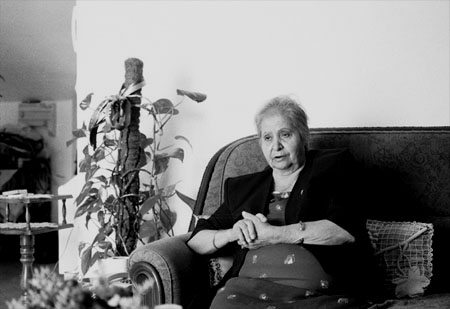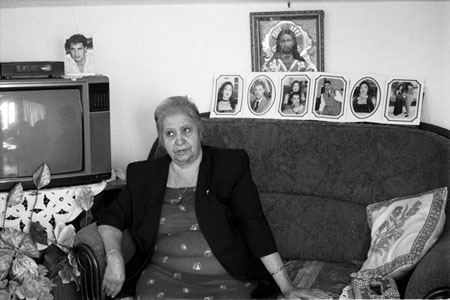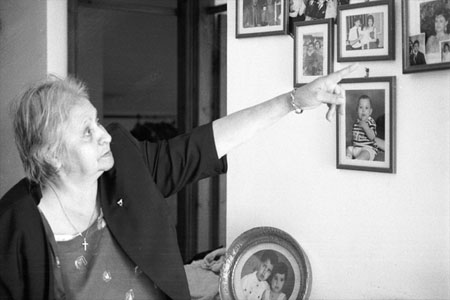
Umm Nakhleh Saqar telling the story of the `death march` from Lydd in 1948, Jaffa.
Photo: Leena Saraste
|
 Umm Nakhleh Saqar telling the story of the `death march` from Lydd in 1948, Jaffa. Photo: Leena Saraste |
| Umm Nakhleh Saqar, Jaffa, April 17, 1999:
|
 Umm Nakhleh Saqar (youngest son in the background) Photo: Leena Saraste |
|
Visiting Umm Nakhleh gives us a view of what's left of Arab Jaffa, as we take a taxi from the missionary guest-house where we are staying to the very end of 'Ajami, not far from the old Arab city's cemetery. When Jaffa fell in 1948, people expelled from nearby villages crowded into 'Ajami, settling into homes left empty by owners who had fled. Recently the Israeli authorities began condemning old Palestinian houses as insecure, forcing their residents to move out, then demolishing the houses to make way for new buildings to be rented to Jewish Israelis. Demolitions can also threaten historic buildings: recently the authorities had been about to pull down the ancient Manshiyyeh Mosque; a crowd of civil engineers (Palestinian and Israeli) had managed to stop them in time.
Another Israeli recent project is to turn the seafront south of Jaffa into a site for handsome holiday villas to rent to rich American Jews. The Municipal Master-Plan aims to absorb and transform what is left of the old Arab city, already dwarfed by its 'sister' city Tel Aviv. Palestinians here form such a small proportion of the population that though they can vote in Municipal elections and have two places reserved for them on the Council, they feel almost powerless to prevent the Judaization of Jaffa. But 15 years ago the League for the Defence of the People of Jaffa was founded by a group of civic-minded Palestinians to preserve Jaffa's Arab heritage. It's sad to think that until 1948 Jaffa was the most cultivated and cosmopolitan city in Palestine. There was an opera, cinemas, and a richly varied social life. The film 'Na'im and Wadi'a' by Najwa Najjar gives an idea how sophisticated middleclass life in Jaffa was. Its decline since 1948 has been dismal. One of Umm Nakhleh's sons, the engineer, has built the family a three-story house where Ajami's housing begins to give way to sand dunes. An ornate bridge, part of the holiday-villa project, stands deserted of traffic, like a piece of film scenery. On the way we pass a grim tenement building. People whose homes in Ajami have been demolished, and cannot afford new rents, moved here. Andre warns me against trying to record with anyone here - it's full of drug-adicts and petty criminals, he says. Umm Nakhleh is looking more frail than last time I saw her, on a brief visit in the autumn of 1998. She has heart problems and feels difficulty in walking. She's wearing black. One of her grandsons was killed recently in a car crash, which she blames on drunken |
drivers, and the coastal autostradas that encourage speeding. In the telling of black events by Israeli Palestinians there is always the sense of an environment over which they, as a marginal minority, have no control.
I'm eager to record her story of the 'death march' from Lydd in July 1948. It seems obvious to me that her frailty now is connected to that experience when, as a young mother with an infant, and pregnant, she was forced to walk with a great mass of expulsees up over the bare mountain eastwards to Ramallah 9; also to the year of semi-starvation she spent as a refugee in Ramallah, where her first daughter died and she gave birth to another who survived. After returning to Jaffa (her husband's home), she gave birth to another seven children. The doctor told her after the fourth birth that having more would be dangerous because of her high blood pressure, but parental pressures made her continue. Her story now, with the recorder open, seems a little less detailed and dramatic than when she first told it to me. Perhaps she has told it too many times? But it's not just the opening episode that makes her narrative interesting, it's what she tells about life after the Nakbeh, after she returned to Jaffa , and about bringing up Palestinian children in Israel. But she begins by telling about the military imbalance between Palestinians and Jews in 1948, since as foreigners Leena and I may not know this.
Umm Nakhleh begins to speak: |
| 9. Michael Palumbo, The Palestinian Catastrophe: The 1948 Expulsion of a People from their Homeland. London: Faber and Faber, 1987, p 126-138. |
 Umm Nakhleh Saqar, Photo: Leena Saraste |
[Leaving Haifa] [Leila, Widad, Suad Andraos] Copyright©2005 |
|